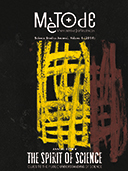Ciència, públic i nous mitjans. Reflexió sobre el present i el futur de la divulgació científica
DOI:
https://doi.org/10.7203/metode.80.3123Paraules clau:
ciència i xarxes socials, comunicació en línia, divulgació científica, percepció pública de la ciència Resum
Resum
El periodisme científic s’enfronta al repte d’adaptar-se no sols a nous formats sinó també a les noves formes d’intercanvi d’informació. Les noves plataformes digitals faciliten l’accés i la producció de continguts científics i, per tant, forcen la seua audiència a evolucionar. La xarxa s’ha convertit en el present de la divulgació científica, i tant els científics com els comunicadors s’hi han d’adaptar. En aquest article analitzarem aquests canvis i les implicacions que tenen per al periodisme científic i per aconseguir una ciutadania informada.
 Descàrregues
Descàrregues
 Referències
Referències
Anderson, A. A.; Brossard, D.; Scheufele, D. A.; Xenos, M. A. and P. Ladwig, 2013. «The “Nasty Effect”: Online Incivility and Risk Perceptions of Emerging Technologies». Journal of Computer Mediated Communication. DOI: <10.1111/jcc4.12009>.
Brossard, D., 2013. «New Media Landscapes and the Science Information Consumer». Proceedings of the National Academy of Science of the United States of America, 110: 14096-14101. DOI: <10.1073/pnas.1212744110>.
Brossard, D. and D. A. Scheufele, 2013. «Science, New Media, and the Public». Science, 339(6115): 40-41. DOI: <101126/science.1232329>.
Brossard, D.; Simis, M.; Yeo, S. and D. A. Scheufele, 2013. Scientists and Social Media at a R1 American University. University of Wisconsin. Madison.
Colson, V., 2011. «Science Blogs as Competing Channels for the Dissemination of Science News». Journalism, 12(7): 889-902. DOI: <10.1177/1464884911412834>.
Corley, E. A.; Kim, Y. and D. A. Scheufele, 2011. «Leading U.S. Nano-scientists’ Perceptions about Media Coverage and the Public Communication of Scientific Research Findings». Journal of Nanoparticle Research, 13(12): 7041-7055. DOI: <10.1007/s11051-011-0617-3>.
Dudo, A.; Dunwoody, S. and D. A. Scheufele, 2011. «The Emergence of Nano News: Tracking Thematic Trends and Changes in Media Coverage of Nanotechnology». Journalism & Mass Communication Quarterly, 88(1): 55-75. DOI: <10.1177/107769901108800104>.
Economisti-Associati, 2011. Feasibility Study for the Preparatory Action «ERASMUS for Journalists»: Part 2 – Statistical Review. Economisti Associati. Bologna.
Fausto, S. et al., 2012. «Research Blogging: Indexing and Registering the Change in Science 2.0». PLoS ONE, 7(12): e50109. DOI: <10.1371/journal.pone.0050109>.
Horrigan, J., 2006. The Internet as a Resource for News and Information about Science. Pew Internet & American Life Project. Washington.
International Telecommunication Union, 2012. Measuring the Information Society. ICT Data and Statistics Division, International Telecommunication Union. Geneva.
LaBarre, S., 2013. «Why We’re Shutting off Our Comments». Popular Science, 24 September.
Ladwing, P.; Anderson, A. A.; Brossard, D.; Scheufele, D. A. and B. Shaw, 2010. «Narrowing the Nano Discourse?». Materials Today, 13: 52-54. DOI: <10.1016/51369-7021(10)70084-5>.
Newman, N. and D. A. L. Levy, 2013. Reuters Institute Digital News Report 2013. Reuters Institute for the Study of Journalism. University of Oxford. Oxford.
Nirenberg, M. W., 1967. «Will Society Be Prepared?». Science, 157(3789): 633. DOI: <10.1126/science.157.3789.633>.
Olmstead, K., Mitchell, A. and T. Rosenstiel, 2011. «Navigating Online News: Where People Go, How They Get There and What Lures Them Away». Pew Research Journalism Project. Available at: <http://www.journalism.org/2011/05/09/navigating-news-online>.
Scheufele, D. A.; Hardy, B. W.; Brossard, D.; Wiasmel-Manor, I. S. and E. Nisbet, 2006. «Democracy Based on Difference: Examining the Links between Structural Heterogeneity, Heterogeneity of Discussion Networks, and Democratic Citizenship». Journal of Communication, 56(4): 728-753. DOI: <10.1111/j.1460-2466.2006.00317.x>.
Shoemaker, P. and T. Vos, 2009. Gatekeeping Theory. Routledge. New York.
Publicades
Com citar
-
Resum1383
-
PDF 392
-
PDF142
-
PDF (Español)323
Número
Secció
Llicència
![]()
Tots els documents inclosos en OJS són d'accés lliure i propietat dels seus autors.
Els autors que publiquen en aquesta revista estan d'acord amb els següents termes:
- Els autors conserven els drets d'autor i garanteixen a la revista el dret a la primera publicació del treball, llicenciat baix una llicència de Reconeixement-NoComercial-SenseObraDerivada 4.0 Internacional de Creative Commons, que permet a altres compartir el treball amb un reconeixement de l'autoria del treball i citant la publicació inicial en aquesta revista.
- Es permet i s'anima els autors a difondre la versió definitiva dels seus treballs electrònicament a través de pàgines personals i institucionals (repositoris institucionals, pàgines web personals o perfils a xarxes professionals o acadèmiques) una vegada publicat el treball.





